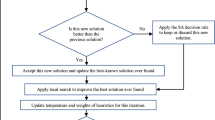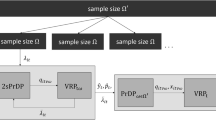Abstract
Two-sided assembly lines are widely applied to produce the large-sized high-volume products, such as buses and trucks. Balancing the lines is a vital design problem for the industries, and the problem is NP-hard. Besides the fundamental constraints of the conventional line balancing problem, some specific constraints may occur in the two-sided assembly line problem, including the zoning constraints, the positional constraints, and the synchronism constraints, which make the problem more complex. In this paper, an integer programming (IP) model is constructed and solved for the two-sided assembly line balancing problem which contains the above three constraints. A novel metaheuristic named late acceptance hill-climbing (LAHC) is also proposed to solve the problem effectively. The proposed algorithm is tested on several sets of instances. The computational results of the LAHC algorithm are compared with those of IP and the lower bounds of the instances. The experiment validates the effectiveness of the LAHC algorithm.



Similar content being viewed by others

References
Abuhamdah, A. (2010). Experimental result of late acceptance randomized descent algorithm for solving course timetabling problems. International Journal of Computer Science and Network Security, 10(1), 192–200.
Abuhamdah, A., & Ayob, M. (2010). Average late acceptance randomized descent algorithm for solving course timetabling problems. In Information Technology (ITSim), 2010 International Symposium (pp. 748–753).
Bartholdi, J. (1993). Balancing two-sided assembly lines: A case study. International Journal of Production Research, 31(10), 2447–2461.
Baykasoglu, A. (2006). Multi-rule multi-objective simulated annealing algorithm for straight and U type assembly line balancing problems. Journal of Intelligent Manufacturing, 17(2), 217–232.
Baykasoglu, A., & Dereli, T. (2008). Two-sided assembly line balancing using an ant-colony-based heuristic. International Journal of Advanced Manufacturing Technology, 36, 582–588.
Burke, E. K., & Bykov, Y. (2008). A late acceptance strategy in hill-climbing for exam timetabling problems. In Conference on the practice and theory of automated timetabling, Montreal, Canada.
Chutima, P., & Chimklai, P. (2012). Multi-objective two-sided mixed-model assembly line balancing using particle swarm optimisation with negative knowledge. Computers & Industrial Engineering, 62(1), 39–55.
Hu, X. F., Wu, E. F., & Jin, Y. (2008). A station-oriented enumerative algorithm for two-sided assembly line balancing. European Journal of Operational Research, 186(1), 435–440.
Hu, X. F., Wu, E. F., Bao, J. S., & Jin, Y. (2010). A branch-and-bound algorithm to minimize the line length of a two-sided assembly line. European Journal of Operational Research, 206(3), 703–707.
Kim, Y. K., Kim, Y. H., & Kim, Y. J. (2000). Two-sided assembly line balancing: A genetic algorithm approach. Production Planning & Control, 11(1), 44–53.
Kim, Y. K., Song, W. S., & Kim, J. H. (2009). A mathematical model and a genetic algorithm for two-sided assembly line balancing. Computers & Operations Research, 36(3), 853–865.
Lee, T. O., Kim, Y., & Kim, Y. K. (2001). Two-sided assembly line balancing to maximize work relatedness and slackness. Computers & Industrial Engineering, 40(3), 273–292.
Ozbakir, L., & Tapkan, P. (2010). Balancing fuzzy multi-objective two-sided assembly lines via bees algorithm. Journal of Intelligent & Fuzzy Systems, 21(5), 317–329.
Ozbakir, L., & Tapkan, P. (2011). Bee colony intelligence in zone constrained two-sided assembly line balancing problem. Expert Systems with Applications, 38(9), 11947–11957.
Ozcan, U. (2010). Balancing stochastic two-sided assembly lines: A chance-constrained, piecewise-linear, mixed integer program and a simulated annealing algorithm. European Journal of Operational Research, 205(1), 81–97.
Ozcan, U., & Toklu, B. (2009a). A new hybrid improvement heuristic approach to simple straight and U-type assembly line balancing problems. Journal of Intelligent Manufacturing, 20(1), 123–136.
Ozcan, U., & Toklu, B. (2009b). Multiple-criteria decision-making in two-sided assembly line balancing: A goal programming and a fuzzy goal programming models. Computers & Operations Research, 36(6), 1955–1965.
Ozcan, U., & Toklu, B. (2009c). A tabu search algorithm for two-sided assembly line balancing. International Journal of Advanced Manufacturing Technology, 43, 822–829.
Ozcan, U., & Toklu, B. (2009d). Balancing of mixed-model two-sided assembly lines. Computers & Industrial Engineering, 57(1), 217–227.
Sabuncuoglu, I., Erel, E., & Tanyer, M. (2000). Assembly line balancing using genetic algorithms. Journal of Intelligent Manufacturing, 11(3), 295–310.
Simaria, A. S., & Vilarinho, P. M. (2009). 2-ANTBAL: An ant colony optimisation algorithm for balancing two-sided assembly lines. Computers & Industrial Engineering, 56(2), 489–506.
Tasan, S. O., & Tunali, S. (2008). A review of the current applications of genetic algorithms in assembly line balancing. Journal of Intelligent Manufacturing, 19(1), 49–69.
Tapkan, P., Ozbakir, L., & Baykasoglu, A. (2012). Bees algorithm for constrained fuzzy multi-objective two-sided assembly line balancing problem. Optimization Letters, 6(6), 1039–1049.
Verstichel, J., & Berghe, G. V. (2009). A late acceptance algorithm for the lock scheduling problem. Logistic Management, 5, 457–478.
Wu, E. F., Jin, Y., Bao, J. S., & Hu, X. F. (2008). A branch-and-bound algorithm for two-sided assembly line balancing. International Journal of Advanced Manufacturing Technology, 39, 1009–1015.
Acknowledgments
The authors thank anonymous referees whose comments helped a lot to improve this paper. This research work is supported by the State Key Program of National Natural Science of China (Grant No. 51035001) and the National Natural Science Foundation of China (Grant No. 51275190).
Author information
Authors and Affiliations
Corresponding author
Rights and permissions
About this article
Cite this article
Yuan, B., Zhang, C. & Shao, X. A late acceptance hill-climbing algorithm for balancing two-sided assembly lines with multiple constraints. J Intell Manuf 26, 159–168 (2015). https://doi.org/10.1007/s10845-013-0770-x
Received:
Accepted:
Published:
Issue Date:
DOI: https://doi.org/10.1007/s10845-013-0770-x



